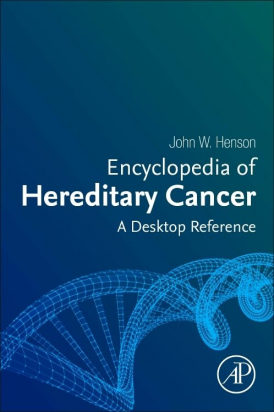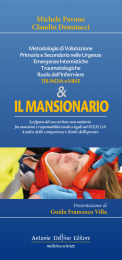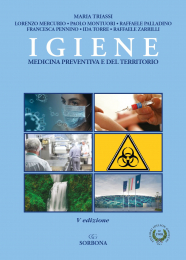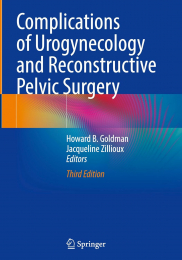Non ci sono recensioni
DA SCONTARE
Encyclopedia of Hereditary Cancer: A Desktop Reference gives insights into this young and rapidly expanding field that combines oncology and genetics to achieve risk reduction, early detection, family risk management, and identification targeted treatments. While genetics and oncology are both well-developed knowledge areas, their combination in hereditary cancer yields an opportunity for new works that systemize knowledge for current researchers, practitioners, and students. The book exams 371 topics through the lens of hereditary cancer. There are no similar books that presents information in this manner.
This reference work contains a complete list of terms and definitions which can be easily reference by researchers and clinicians working in this field.
Activating Variant IMAGE CONCEPT include hemizygous
Allele
Allele frequency
Allelic disorder
Allelic dropout
Alteration/variant/ mutation
Alternate parentage
Alu repeats
Amino acid
Amplicon. Include tiling density
Amplification
Aneuploid
Angiomyolipoma
Ankyrin repeat
Anticipation
APOBEC
Aspirin
Autosomes
Autosomal dominant
Autosomal recessive
Basal cell carcinoma
Base excision repair
BAP1 tumor predisposition syndrome
Belzutifan
Biallelic
Biallelic/compound heterozygosity
Birt Hogg Dube syndrome
Blastomere
BRCA pathway
Breast carcinoma
Breast tissue density
Bromodomain
BRRS
Cancer risk factors
CanRisk estimator
Carcinoma of unknown primary
Carotid body tumor
Cascade testing
Catalytic RNA
cfDNA/ctDNA
Checkpoint inhibitor
CHIP/ACE
Chorionic villus sampling
Chromosomal changes
Chromosomal microarray
Chromosomes
Cis
Colorectal cancer
Communicating results
Compound heterozygote
Congenital hypertrophy of the retinal pigment epithelium
Consanguinity
Constitutional/germline/gonadal
Constitutional mismatch repair deficiency
Consultand
Contiguous gene deletion syndrome
Copy-neutral loss of heterozygosity
Copy number alteration
Cortical tuber
Cowden syndrome
CpG island methylator phenotype
CpG islands
Deamination
Deletion
Delphi process
De novo hereditary/de novo tumor
De novo variant
DICER1 syndrome
Differing interpretation from two testing companies
Digenic modifiers
Digenic inheritance
Diploid
DNA damage
DNA – mitochondrial
DNA – nuclear
DNA quality
DNA repair
DNA sequence alterations - endogenous metabolic damage causing abundant G:C>T:A transversions
DNA sequence alterations - cytosine deamination
DNA sequence alterations - endogenous metabolic damage
DNA sequence alterations – environmental
DNA sequence alterations – replication
Dominant negative
Double heterozygote
Double somatic
Double strand break
Driver mutation
Duplication
Duty to recontact with new information
Dysplastic gangliocytoma of the cerebellum
Embryonic lethal
Endoscopic ultrasound
Endometrial carcinoma
Endolymphatic sac tumor
Environmental influences
Epigenetics
Epimutation
Epimutations
Esophagoduodenoscopy
Estrogen
Everolimus
Exon
Exonuclease
Expression
Familial
Familial adenomatous polyposis
Familial atypical multiple mole melanoma syndrome
Familial isolated pituitary adenoma
Familial medullary thyroid cancer
Fanconi anemia
FDA label
Fidelity
First degree relative
Fluorescent in situ hybridization
Founder variants
Frameshift
Functional haploidy
Fusion
Gain of function
Gamete
Gastric adenocarcinoma and proximal polyposis of the stomach
Gastric cancer
Gastro-entero-pancreatic
Gene conversion
Gene conversion/reduction to homozygosity
Gene dosage
Genes
Genetic
Genetic modifiers
Genome-wide loss of heterozygosity
Genome sequencing/ES
Genomic
Germline
GINA
Glomus tumors
Gonadal mosaicism
Glycosylase
Gorlin syndrome
Hamartin
Hamartoma
Haploid
Haploinsufficiency vs spontaneous mutation, noncancer syndromic features
Hedgehog
Hemangioblastoma
Hemizygosity
Hereditary
Hereditary breast and ovarian cancer syndrome
Hereditary diffuse gastric cancer
Hereditary/familial
Hereditary leiomyoma and renal cell cancer syndrome
Hereditary papillary renal cell carcinoma
Hereditary paraganglioma/pheochromocytoma
Heterozygous
HGVS nomenclature
Histones
Holliday junction
Homologous recombination deficiency
Homologous repair defect
Homozygous
Hormonal influence
Hotspot
Human reference genome
Hypomorphic variant – amorphic allele
Hypoxia
Immunohistochemistry
Immunotherapy
Imprinting
Inactivating
Indel
In-frame
Intron
Insertions and deletions
Ionizing radiation
Isodisomy
Juvenile Polyposis of Infancy
Kindred
Lagging strand
Large alterations – amplification
Large alterations – deletion
Large alterations - Fusion/translocation
Leiomyoma
Lipoma
Li-Fraumeni syndrome
Leading strand
Likely pathogenic variant
Limitations of reports
Lhermitte-Duclos
Locus
LOH
Loss of function
Loss of heterozygosity
Low allele frequency (10% reporting)
Lumpectomy
Lymphangioleiomyomatosis
Lynch syndrome
Lyonization
Macrocephaly
Malignant peripheral nerve sheath tumor
Magnetic resonance cholangiopancreatography
Mastectomy
Maternal to zygotic transition
Medical sophistication
Medullary thyroid cancer
Meiosis
Melanoma
Methylation
Mesothelioma
Metanephrines
Microdeletion
MicroRNA
Microsatellite
Microsatellite instability
Minor allele fraction (10% reporting threshold) see also VAF
Misincorporation
Mismatch repair
Missense variant
Mitosis
Molecular complexity
Monogenic
Mosaic
Mosaicism
Mosaicism, low level
Multifocal micronodular pneumocyte hyperplasia
Multiple endocrine neoplasia type 1
Multiple endocrine neoplasia type 2
Mutation cluster region
mRNA alterations
Muir-Torre syndrome
Multigene panel
Mutation
Mutation signature
MUTYH polyposis
National Comprehensive Cancer Network
Neurofibromatosis type 1
Neurofibromatosis type 2
Nevoid basal cell carcinoma
Next generation sequencing
Nephrectomy
Neuroendocrine tumor
Neurofibroma
Noninvasive prenatal diagnosis
Nonsense mediated decay
Nonsense variant
Nucleotide excision repair
Null mutation
Olaparib
Oncogene
Open reading frame
Orthogonal technique
Ovarian cancer
Overexpression
Oxidative damage
Paired tumor-germline testing
Pancreas cancer
Pancreatitis
Paraganglioma
Parent-of-origin effect
PARP
Pathway
Passenger mutation
Pathogenic variant
PD-L1
Pedigree
Pembrolizumab
Penetrance and expressivity
Peutz-Jegher syndrome
Pharmacogenomics
Phenocopies
Pheochromocytoma
Pituitary adenoma predisposition syndrome
Plexiform neurofibroma
Polyadenylation
Poly ADP ribose polymerase
Polygenic
Polymerase
Polymerase proofreading polyposis syndrome
Polymorphism
Polyp
POT1-tumor predisposition syndrome
Population database
Preimplantation genetic diagnosis
Prevention
Premature termination codon
Proband
Proficient
Promoter
Prostate cancer
Prostate specific antigen
Protein alterations
Pseudogene
PTEN hamartoma tumor syndrome
Red flags
Reduction to homozygosity
Reference genome
Reference transcript
Reimbursement
Renal cell carcinoma
Replication slippage
Reportable variants
Residual Risk
RET
Retinoblastoma
Reversion mutant
Ribosomal alterations
Risk assessment
Risk factors
Risk reducing surgery
Rhabdomyoma
Rs
Schwannomatosis
Scoliosis
Second hit
Sentinel lymph node
Simplex case
Single-base substitutions
Single nucleotide polymorphism
Single strand break
SNP
Somatic/tumor
Somatic variant classification
Splicing
Sporadic
Standardized uptake value
Subclone
Subependymal giant cell astrocytoma
Subependymal nodule
Surveillance
Syndromic
Synonymous mutation
Synonymous/silent variants. Splicing
Synthetic lethal
Targeted therapy
Telomere
Testing guidelines – shortcomings
Testing implications – benefits
Thyroid cancer
Tissues to test
Translocation
Transvaginal ultrasound
Tricholemmoma
Triploid – RCC MET
Topoisomerase
Trans
Transition
Transversion
Tuberin
Tuberous sclerosis complex
Tumor mutation burden
Tumor percentage
Tumor suppressor gene (TSG)
Two-hit (Knudson)
Tyrer-Cuzick risk estimation
Tyrosine kinase
Ultraviolet radiation
Uniparental disomy (isodisomy and heterodisomy)
Untranslated regions
Upstream regulatory regions
Uracil misincorporation
Variant allele frequency (also MAF)
Variant classification
Variant of uncertain significance
Variant not detected
Variant of uncertain significance
Vestibular schwannoma
Vismodegib
Von Hippel Lindau Syndrome
Whole body MRI
Zygosity
8-oxoG
5’ untranslated region
3’ untranslated region




